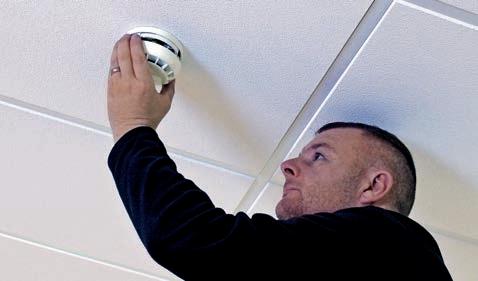
6 minute read
Eliminating Legionella fears with smart technology
Matthew Margetts, Director of Sales and Marketing at Smarter Technologies, looks at how the threat of Legionella can be eliminated with smart technology, as commercial premises reopen after lockdown.
Advertisement
Legionella is the cause of Legionnaires’ Disease While commercial premises are reopening following coronavirus closures, a great number of workers remain at home and many buildings are closed.
With our eyes firmly on the control of the spread of COVID-19, prolonged closure of buildings poses another health risk in the form of Legionella. These bacteria are the cause of Legionnaires’ Disease, which is similar to pneumonia and is potentially fatal, killing one in 10 infected people.
Legionella has made a number of headlines recently. After Legionella was detected in the Royal Navy command headquarters in Portsmouth, the building had to be temporarily closed in the interests of health and safety, for instance. The increase in observations of the bacteria has prompted Public Health England to warn the public about flushing water systems on reopening to mitigate the risk. Smart technologies offer an immediate solution that significantly reduces Legionella risks.
What is the cause of Legionella? Legionella bacteria thrive in stagnant water between 20° and 50°C. Unused taps, pipes, and storage tanks are some of the most common breeding grounds for bacteria growth, but there are some other parts of buildings to consider too – like ‘dead legs’, areas affected by rust and scale, and faulty valves and filters. fines or imprisonment if found guilty of non-compliance.
The traditional approach to Legionella maintenance is a labour-intensive process, involving manual flushing and temperature testing of water flow. A risk assessment provides guidance on the regularity and parameters of this testing for compliance purposes. Smart technologies have transformed conventional methods – providing automated testing and precision reporting for total compliance and workplace safety around water systems. As businesses reopen, these cost-effective, smart solutions are addressing the immediate needs of business owners, with a long-term appeal.
• Manual versus automated processes
For the average business in the UK, the manual process involves weekly manual flushing and testing – running hot and cold water for two minutes and recording temperatures, as well as twice-yearly hot water storage cylinder and cold water tank checks. Once installed, smart solutions conduct these readings automatically to meet compliance schedules.
• Man versus machine
This involves human resource, whether outsourced or internal, both of which come at a cost. As processes are digitalised and brought into the future, the main benefits are unquestionably the cost of employing staff to carry out the checks. In Legionella maintenance, there is also the added benefit of uniform, consistent methods, which makes for demonstrable fulfilment of compliance obligations. It also gives accurate data readings through which you can conduct meaningful trend analyses.
Exposure to disease-carrying contaminants is also a consideration when it comes to these testing processes – a risk that is eliminated through smart, automated processes.
• Time spent versus time saved
Obviously, manual temperature monitoring takes time. This is put into stark relief when one considers how automated compliance systems gather data consistently and automatically in the background. Automated Legionella compliance systems will alert selected personnel on any undesirable water owners and facilities managers the opportunity to respond immediately.
This ability to react to changes in real time has an additional benefit. The early detection of changes can assist maintenance teams in identifying and locating the existence of faults which, depending on pipeworks systems and building size, can be a very costly and time-consuming task.
• Manual record-keeping versus cloud-based reporting
Businesses are required to keep Legionella maintenance records for five years, which presents an administrative burden for owners and facilities managers. Gaps in records, human error, and inefficient record-keeping could mean temperature readings, giving business
Smart, automated Legionella compliance systems send readings to a remotely accessible dashboard in real time. This cloud-based solution means detailed, accurate records can be accumulated and stored – unaffected by human error, changes in administrative staff, or equipment failures.
Go forward. Go smarter The simplicity and cost-effectiveness of an automated Legionella compliance system makes it an accessible, modern solution to an everyday requirement. Central to alleviating Legionella-related health and compliance concerns, they are designed to provide accurate, actionable insights. Some are also up to 71% less expensive than manual testing in buildings of approximately 5,000 to 10,000sq-ft. Pipe temperature sensors, wireless tank temperature sensors, and automatic temperature testing and flushing units are controlled through a smart building platform to give real-time alerts on temperature fluctuations.
Smarter Technologies conducted an experiment with its own technology – under the same conditions – and found that the average annual cost of four universal testing units and hot and cold water storage temperature monitoring units (including hardware) will be £757.08. The total cost over five years will be £3,785.40. This means that facilities managers can get an average annual saving of £1,738.92, with the business saving £8,964.60 over five years.
By making the switch to automated legionella regimes now then, facilities owners can drive efficiencies, reduce costs and make a fully informed switch for futureproofing their business safety needs.
Stay compliant with the Brother label printer and new Pro Tape range
The Brother PT-E550W label printer lets you print compliant labels instantly on-site. And with our new Pro Tape range, designed with professional applications in mind, we’re confident we have the perfect solution for you to get the job done.


33% off*
MARK SMARTAOF PROFESSIONAL
Heatshrink tape Self-laminating

Strong adhesive


Flexible ID tape
To order today, please visit us in-store or online:
NEXT TIME…
In addition to its regular range of news and viewpoints, the December issue of ECN will contain special features relating to smart buildings, test equipment and UPS & power distribution.
The features will include articles and information from major companies, providing a range of information about the latest issues and technological developments affecting the sectors. For electrical contractors, the features will prove to be a valuable reference point for all that is happening within this area.
*Offer available on the PT-E550WVP until 30th November 2020

Control energy use in multi-room dwellings Ecostat is always striving to minimise heat output
Landlords can be confident that they aren’t using energy unnecessarily and could be saving 25-35%* on their energy costs. Occupants can raise or lower the temperature within agreed parameters but programs cannot be changed on the controller. Ecostat knows if rooms are unoccupied or if windows are open and adjusts the heat input accordingly.
Ideal for student accommodation, hotels, leisure resorts etc.

• PIR presence/absence detection • Open-window technology • Tamper-proof • Lot 20 compliant • Boost, set-back and frost setting • 2 event - 7 day timer • Electric or ‘wet’ systems • Ideal for retro-fitting • Dedicated hand-set adjusts programs • 45 minute Non-invasive install.










